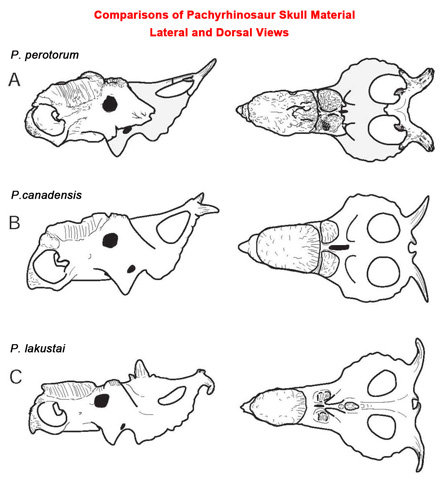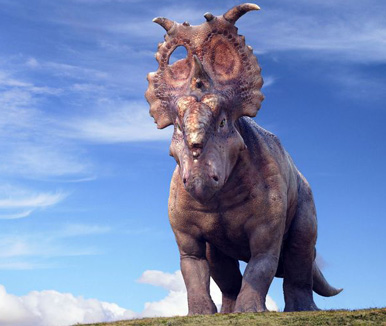Step Forward the Pachyrhinosaurs – Stars of Forthcoming Dinosaur Film
Details of the Plot of the Eagerly Awaited “Walking with Dinosaurs in 3-D”
The film “Walking with Dinosaurs in 3-D” is due to have its premier on December 20th this year, team members at Everything Dinosaur have reviewed the trailer and now we can reveal the basic storyline. Get ready to join a herd of pachyrhinosaurs on their long migration and battle for survival in the Late Cretaceous. The film, which has involved the BBC and a number of other commercial partners, features the stories of three pachyrhinosaurs, Patchi, his brother Scowler and a female called Juniper.
The Trials and Tribulations of Pachyrhinosaurs
From the hazards of hatching through to surviving into adulthood and the challenges of becoming herd leader, the movie features a host of CGI created prehistoric animals that lived in North America in what is termed the Maastrichtian faunal stage of the Late Cretaceous.
Three species of pachyrhinosaur are currently recognised, the first of which P. canadensis was named and described back in 1950. A member of the horned dinosaurs group, there was a substantial ridge of bone above the nose (a boss). Some scientists have suggested that this ridge supported a single horn, a trait seen in other centrosaurines, however, despite many fossil finds including almost complete individuals, no evidence of an actual nose horn has been found to date. This ridge of bone gives this genus its name, Pachyrhinosaurus means “thick-nosed lizard”.
Three Species of Pachyrhinosaurs have been Described to Date
Walking with Dinosaurs
The film makers have opted to give their CGI created pachyrhinosaurs no nose horn although the prominent boss is present and to our eyes it seems that the pachyrhinosaur species featured is P. canadensis. The promoters of the movie have created the strapline “the biggest 3-D event in 100 million years”, not accurate, as the action takes place around 70 million years ago, the strapline’s chronological error being most likely attributed to the needs of marketing overriding and concerns for palaeontology. After all, this is entertainment, although a number of palaeontologists and other academics have acted as scientific consultants to the production crew.
Sceptics have already dubbed this “March of the Penguins meets Bambi”, but no matter, the film will make millions for all those associated with it including 20th Century Fox.
Telling Pachyrhinosaurs Apart
One of the problems the story tellers encountered was how to make the hero Patchi stand out from the rest of the pachyrhinosaur herd. An early dromaeosaur attack gives our horned-headed hero a deformed frill, the right fenestra was damaged and the covering of skin lost, so that our protagonist can be easily spotted – he’s the one with a hole in his head – literally.
Palaeontologist Scott Sampson, who advised on the film commented:
“This is Pachyrhinosaurus’ chance to shine. It’s an ornate and just phenomenal creature. A lot of other dinosaurs haven’t had the exposure that T. rex or Triceratops get. So it’s nice to see some others become part of the dinosaur iconography.”
Gorgosaurus
Along with the ceratopsians, expect to see fearsome tyrannosaurs, (the villain of the piece is a ferocious Gorgosaurus called Gorgon), armoured dinosaurs, hadrosaurs and giant azhdarchid pterosaurs, some of which attempt to make a baby Pachyrhinosaurus a tasty snack.
Co-director Barry Cook explained that the story unfolds with the help of a narrator called Alex, one of the Alexornis birds. Birds were a very common sight in the Late Cretaceous of North America. This narration is supplemented with in-the-moment voice-overs from the main characters “as if we are hearing their thoughts”, according to Barry.
Pachyrhinosaurus Get Star Billing
Picture credit: 20th Century Fox
The film makers have not used any puppetry, unlike the seminal BBC television series “Walking with Dinosaurs” which first aired in 1999. Close up shots of the prehistoric animals in this iconic series were achieved by the use of sophisticated marionettes. These days, advanced computer imagery means that the dinosaurs are all created using software, there are no strings or glove puppets to be seen.
The film does have one thing in common with the original BBC series, it proved very hard to find suitable locations in which to place the CGI dinosaurs. In the end, the production team chose to film in Alaska (rugged mountain shots) and New Zealand. Ironically, pachyrhinosaurs would have felt very much at home in Alaska, the fossils of one of the recently discovered species of pachyrhinosaur (P. perotorum) were discovered in Alaska.
To read about this fossil find: New Species of Pachyrhinosaur Announced.
The film is going to get a lot children (and their parents) very excited on its release in just under four months time.



